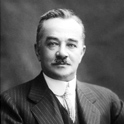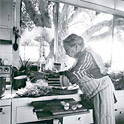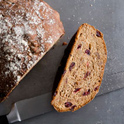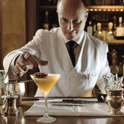For years, my craving for mangosteen, the “Queen of Fruits,” made me an unwitting accomplice in a deadly serious game of hide-and-seek. The players in this fruit-inspired drama were not G-men and counterfeiters but federal agricultural inspectors and produce sellers in New York City’s Chinatown. Asian friends had told me that one store secretly carried the legendary tropical fruit, which is banned from importation into the United States because it can host agricultural pests. But each time I asked the vendor if he had any, he just shook his head and muttered darkly, “No mangosteen.”
Having faithfully bought crates of lychees from the fellow for years, however, I eventually gained his confidence. One day, after looking around warily, he led me to a back room, opened a padlocked compartment, and handed me a heavy box of handsome maroon orbs—Thai mangosteens legally imported into Canada, where tropical pests are not a concern, and smuggled south by truck. I cut open a thick rind to reveal six snowy white, almost translucent segments that were like little eggs nestled in a jewel box. The flavor was almost unbearably exquisite—a sweet-tart melding of elegance and opulence that had echoes of fruit of every climate. Think of cherimoyas, lychees, and peaches mingled into one soft, moist, fragrant mouthful. I understood at last why many people consider mangosteen the finest fruit in the world—and why Queen Victoria is said to have offered a knighthood to anybody who could bring her one.
Desperate for more, I called dozens of importers but couldn’t track down a single legitimate source. I tried canned and frozen mangosteen, but they had none of the subtlety of the fresh fruit. At cocktail parties and in chat rooms, I met legions of like-minded devotees who begged me to locate a supply. And thus began the quest that brought me to the Big Island of Hawaii and my personal holy grail of fruitdom, the first commercial mangosteen harvest in the U.S. I also witnessed the birth of a whole new industry in Hawaii, one that may provide much-needed livelihoods, preserve endangered farms, and transform the fruit markets of the U.S.
From Kona, on the sunny western coast, I drove over the black volcanic crags of Mauna Kea to reach Hilo, on the cloudier eastern side of the island, where land is less expensive. Cooler, lusher, and less touristy than Kona, the area resembles a postcard from the 1950s. Fifteen miles north of Hilo, at the end of an allée of soaring Cuban royal palms, was the farm of Brian Paxton, a trim, mustachioed Australian horticulturist who has helped plant 600 acres of exotic fruits on Hawaii during the past decade.
“This was all sugarcane land, but there’s virtually no cane left in Hawaii,” he said, surveying ten acres of orchards as carefully manicured as a Beverly Hills lawn. “Sugar growers can’t compete with foreign producers, who have lower labor costs.” Desperate to find a use for the vacant land and unemployed labor, Hawaiians have gambled on upscale tropical fruit—mostly longan and rambutan, two relatives of lychee, but also the prized mangosteen.
We walked over to Paxton’s greenhouse, where he showed me why growers had hesitated to plant mangosteen despite its mythic appeal: His two-year-old trees were barely two feet high. Hawaii may seem quintessentially tropical, he explained, but mangosteen actually prefers the hotter, more equatorial climate of its native Southeast Asia. Even there, though, the trees grow exasperatingly slowly, taking up to 10 years to bear fruit. In Hawaii, they can take as long as 12 years.
Fortunately, three quarters of Paxton’s mangosteen trees are mature and starting to bear. On a tour of the orchard, I reached into the shapely dark green trees for the fresh fruit and bit greedily into the juicy flesh. It was even more delicious than the mangosteens I had tasted in New York, with the silky, heady richness that gives the fruit its power.
It’s still early days, but we are getting good results,” said Paxton. “I’m sure mangosteen can be grown commercially here, but because the soil and the climate are different than those of Asia and Australia, farming practices have to follow suit.” Growers are still sorting out which locations and agricultural techniques will result in successful crops.
Most exotic-fruit farmers in Hawaii diversify their plantings, and Paxton himself has circumvented uncertainty by making much of his living selling trees (and expertise) to aspiring growers. Many are wealthy individuals like Liloa Willard, whose great-grandfather married into the Hawaiian royal family. He built a 43-acre showpiece intended to demonstrate to native Hawaiians the practicality of cultivating exotic fruits. But once he overcame the challenge of getting mangosteens to bear, the thrill was gone. He moved on to vineyards in New Zealand and put his estate on the market.
The mangosteen mystique has fostered something of a gold-rush mentality in Hawaii. When I stopped for lunch at the Woodshop Gallery & Café, near the famous Akaka Falls, both the owner and the waitress were considering planting orchards even though neither of them had ever tasted a mangosteen. After they had sampled my stash (better than a hotel fruit basket any day), their eyes gleamed with newfound conviction.
For their dream to come true, growers must find markets for their product. Exotic fruits such as mangosteen, longan, and papaya have flourished in home orchards in Hawaii since the 19th century, but they were never grown commercially because the in-state market was limited. (In recent decades a fruit fly infestation there led to a quarantine on untreated shipments to the mainland.) Along with the demise of sugarcane and advances in growing techniques, two factors have spurred recent large-scale plantings: demand from America’s increasing Asian population, and, most critically, the opening in August 2000 of an irradiation facility that has enabled high-quality fruits to be shipped to the mainland, where they fetch $6 to $8 a pound at retail.


 Pinterest
Pinterest






